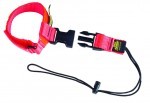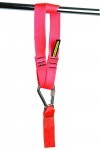Gear Keeper© Tool & Instrument Tethering Systems let safety engineers choose the proper configuration for every application.

Gear Keeper retractable tethers, particularly important when working in close quarters or climbing, fulfill the safety engineers’ goal for correct tethering procedures for tools up to two pounds.
The common lanyard-type tool tether is not a one-size-fits-all solution. With such a high risk to workers’ safety, it’s unfortunate that very little has been published regarding tethering equipment and tethering safety techniques. As a result, many safety professionals may not be aware of the range of options available to them. When tool tethers are ordered without specifications beyond the weight of the tool, it’s likely that the tether will not be appropriate.
An improperly mated tool and lanyard can inherently lead to reduced productivity and exposure to injury if the tethering device limits mobility, recoils too fast or exerts too much resistance upon extension. Generally the result is fatigue, annoyance and non-compliance in the use of the lanyard. However when the tool, employee and application are correctly mated, working aloft becomes easier and more efficient. Employees will appreciate always having their tools and instruments conveniently at hand when they need them and out of the way when they don’t. But what is the best choice for each application; Retractable tool tether, lanyard tool tether or anchored tool tether?
Gear Keeper retractable tethers, particularly important when working in close quarters or climbing, fulfill the safety engineers’ goal for correct tethering procedures for tools up to two pounds. Retractable tethers keep tools close to the body and are engineered so that the tool, application and recoil/retraction force are in balance. When a Gear Keeper retractable tether is extended for use, only minimal force is necessary thereby avoiding worker fatigue or in the reverse, causing a ”kick” when the tool is automatically retracted.

Anchored tethering transfers the shock load produced by a dropped tool from the worker to the structure.
Gear Keeper personal tool tethers, for tools up to five pounds, provide a lanyard that has very low stretch force so as not to fatigue the user at full extension while still providing the proper degree of recoil. Gear Keeper tethers achieves this by having the elastic material sewn inside the webbing during the manufacturing process and not assembled after the fact. In this manner, the elastic provides optimum retraction tension and low force stretch.
For heavier tools, tethers should be anchored to a structure not a person. Anchored tethering transfers the shock load produced by a dropped tool from the worker to the structure. Tethering heavy tools (generally over 10 pounds), to a person is a significant safety concern and safety engineers should consider using anchor tethers.
According to John Salentine, VP of Hammerhead Industries, “A properly tethered tool or instrument makes work more efficient and simplifies every repair, maintenance or manufacturing project. Salentine added, “When tethers complement the tool, worker and application, your employee will be an advocate rather that an antagonist.”
With millions of systems in use, Gear Keeper devices have a failure rate of less than .001 percent. The full line of Gear Keeper instrument tethers and accessories are available on the company’s website at www.gearkeeper.com. A free, four-page tool tether brochure containing the tethering guide and related information is available by calling Hammerhead Industries’ Customer Service at 888.588.9981. The TOOL TETHER GUIDE is also available for download at: http://www.gearkeeper.com/tooltethers/index.html nike air max nike air max
